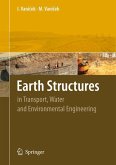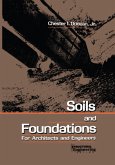- Gebundenes Buch
- Merkliste
- Auf die Merkliste
- Bewerten Bewerten
- Teilen
- Produkt teilen
- Produkterinnerung
- Produkterinnerung
The history of geosynthetics began over fifty years ago worldwide. It is still in the process of being written by engineers, researchers and enthusiasts, who see these products as a concrete response to the environmental challenges facing our society. Geosynthetics from Yesterday to Today presents the basic concepts and notions required for the use, application, dimensioning and durability of these products, which have constantly improved over time to meet ever-changing technical and environmental challenges. Based on experience acquired in France over several decades, this book establishes…mehr
Andere Kunden interessierten sich auch für
![Applied High-Resolution Geophysical Methods Applied High-Resolution Geophysical Methods]() P. K. TrabantApplied High-Resolution Geophysical Methods39,99 €
P. K. TrabantApplied High-Resolution Geophysical Methods39,99 €![Ground Vibration Engineering Ground Vibration Engineering]() Milutin SrbulovGround Vibration Engineering76,99 €
Milutin SrbulovGround Vibration Engineering76,99 €![Routine Data Processing in Earthquake Seismology Routine Data Processing in Earthquake Seismology]() Jens HavskovRoutine Data Processing in Earthquake Seismology80,99 €
Jens HavskovRoutine Data Processing in Earthquake Seismology80,99 €![Trends in Continuum Mechanics of Porous Media Trends in Continuum Mechanics of Porous Media]() Reint de BoerTrends in Continuum Mechanics of Porous Media103,99 €
Reint de BoerTrends in Continuum Mechanics of Porous Media103,99 €![Engineering Geology Engineering Geology]() W. Henry PenningEngineering Geology30,99 €
W. Henry PenningEngineering Geology30,99 €![Earth Structures Earth Structures]() Ivan VanicekEarth Structures151,99 €
Ivan VanicekEarth Structures151,99 €![Soils and Foundations for Architects and Engineers Soils and Foundations for Architects and Engineers]() Chester I. DuncanSoils and Foundations for Architects and Engineers151,99 €
Chester I. DuncanSoils and Foundations for Architects and Engineers151,99 €-
-
-
The history of geosynthetics began over fifty years ago worldwide. It is still in the process of being written by engineers, researchers and enthusiasts, who see these products as a concrete response to the environmental challenges facing our society. Geosynthetics from Yesterday to Today presents the basic concepts and notions required for the use, application, dimensioning and durability of these products, which have constantly improved over time to meet ever-changing technical and environmental challenges. Based on experience acquired in France over several decades, this book establishes the soundness of these techniques and explains their concept and evolution. It is aimed at both beginners and experienced engineers, who are keen to learn more about this fascinating subject.
Produktdetails
- Produktdetails
- Verlag: Wiley
- Seitenzahl: 352
- Erscheinungstermin: 6. Mai 2025
- Englisch
- Abmessung: 234mm x 156mm x 21mm
- Gewicht: 667g
- ISBN-13: 9781789451757
- ISBN-10: 1789451752
- Artikelnr.: 73786278
- Herstellerkennzeichnung
- Libri GmbH
- Europaallee 1
- 36244 Bad Hersfeld
- gpsr@libri.de
- Verlag: Wiley
- Seitenzahl: 352
- Erscheinungstermin: 6. Mai 2025
- Englisch
- Abmessung: 234mm x 156mm x 21mm
- Gewicht: 667g
- ISBN-13: 9781789451757
- ISBN-10: 1789451752
- Artikelnr.: 73786278
- Herstellerkennzeichnung
- Libri GmbH
- Europaallee 1
- 36244 Bad Hersfeld
- gpsr@libri.de
Pascal Villard works as a University Professor at Grenoble Alpes University, France, and as a researcher at the 3SR-Lab. He is also Lecturer in Civil Engineering at Grenoble IUT1.
Foreword xi
J.p. Giroud
Acknowledgements xv
Chapter 1 Geosynthetics: Function, Properties and Characterization 1
Pascal VILLARD
1.1 Definition 1
1.1.1 Geotextiles and geotextile-related products 2
1.1.2 Geomembranes 2
1.1.3 Geosynthetic clay barriers 3
1.1.4 Standard practices 3
1.2 The various functions and applications of geosynthetics 4
1.2.1 Separation 5
1.2.2 Filtration 5
1.2.3 Drainage 6
1.2.4 Reinforcement 7
1.2.5 Sealing 9
1.2.6 Protection 9
1.2.7 Erosion protection 10
1.2.8 Crack inhibition 10
1.3 Properties of geosynthetics and principal characterization tests 11
1.3.1 Mechanical properties 11
1.3.2 Hydraulic properties 13
1.3.3 Properties of the interface 16
1.4 Developments and additions 19
1.5 References 20
Chapter 2 Reinforcement 23
Philippe DELMAS and Jean-Pierre GOURC
2.1 Introduction 23
2.2 Soil reinforcement mechanisms 24
2.3 Reinforcement geosynthetics and their characterization when used as
reinforcement 28
2.3.1 The different types 28
2.3.2 Nominal characteristics and general behaviors 29
2.4 Design and installation of geosynthetic reinforcements 43
2.4.1 Reinforcing an embankment on soft soil: a case of deliberately
accepted partial punching (Aulnois embankment) 45
2.4.2 Reinforcement of an embankment on soft soil: examining circular
failure (A64, the Guiche test embankment, France) 51
2.4.3 Stabilization of a thin layer on a slope: the case of stabilization
of a geosynthetic lining system on a slope 58
2.4.4 Reinforcement of an embankment over potential subsidence area 65
2.4.5 Reinforced multilayer embankment 71
2.5 References 77
Chapter 3 Numerical Models Specific to Reinforcement 81
Audrey HUCKERT and Francis TANO
3.1 Introduction 81
3.1.1 The place of numerical modeling in designing geosynthetics 81
3.1.2 General information: continuous modeling 82
3.1.3 General information: discrete modeling 84
3.2 Applying continuous modeling 87
3.2.1 Principle behind the modeling of the geosynthetic reinforcement 88
3.2.2 Application of continuous modeling - Example 1 90
3.2.3 Application of continuous modeling - Example 2 94
3.3 Application of discrete modeling 96
3.3.1 Principle behind the modeling of the geosynthetic reinforcement 96
3.3.2 Example of application 1: wall made of reinforced soil 101
3.3.3 Example of application 2: safeguarding against the risk of cavities
106
3.4 References 110
Chapter 4 Barrier and Drainage Functions: Non-hazardous Waste Landfills and
Hydraulic Structures 113
Nathalie TOUZE
4.1 Introduction 113
4.2 Geosynthetic barriers 114
4.2.1 The barrier function 114
4.2.2 The geosynthetic materials used to make barriers 114
4.2.3 Performance of the barriers 119
4.3 Geosynthetic sealing systems 121
4.3.1 Support structure 121
4.3.2 Upper protective structure 124
4.4 Drainage 127
4.4.1 Definition of the concept of drainage 127
4.4.2 Specific information related to waste storage facilities 128
4.4.3 Specific features of hydraulic structures 128
4.5 Concept of equivalence 130
4.5.1 Case of the passive barrier 130
4.5.2 Drainage 131
4.6 The impact of transfers within the barriers 132
4.6.1 Importance of inspections during installation 132
4.6.2 Quantification of transfers 133
4.7 Points to remember 140
4.8 References 142
Chapter 5 Geosynthetic Filters: Uses, Feedback from Experience and Current
Research 147
Guillaume STOLTZ
5.1 Introduction 147
5.2 General information on filtration using geosynthetics 148
5.2.1 Filtration function 148
5.2.2 Filter geosynthetics and drainage geocomposites 150
5.2.3 The role of geotextile filters and their applications 153
5.2.4 Reference documents for design 155
5.3 Design methodology (compacted soils) 156
5.3.1 General principles 156
5.3.2 Essential characteristics of geotextile filters 158
5.3.3 Design criteria 160
5.3.4 Causes of failure 164
5.3.5 Compatibility tests for soil-geotextile combinations 168
5.3.6 Going further 171
5.4 Geotextile filtration of a suspension or sludge 174
5.5 Feedback from experience from earthwork structures 175
5.5.1 Introduction 175
5.5.2 Roissard trench drains 176
5.5.3 Valcros dam 177
5.6 Conclusion 179
5.7 References 180
Chapter 6 Durability of Geosynthetics 185
Laetitia VAN SCHOORS and Fabienne FARCAS
6.1 Introduction 185
6.2 Main causes for the aging of geosynthetics 187
6.2.1 Physical aging 187
6.2.2 Chemical aging 189
6.3 Impact of aging on the performance of geosynthetics 192
6.3.1 Polyolefins 193
6.3.2 Polyvinyl chloride 196
6.3.3 Polyethylene terephthalate 198
6.3.4 Polyamides and polyaramids 203
6.3.5 Polyvinyl alcohol 206
6.4 Conclusion 207
6.5 References 208
Chapter 7 A Review of the Use and Behavior of Geosynthetics in France in
the Past 50 Years 215
Jean-Pierre GOURC and Philippe DELMAS
7.1 Relevance of a review of decades-old geosynthetic constructions 215
7.1.1 Concepts and geotechnology 216
7.1.2 Design and construction 216
7.1.3 Long-term behavior and lessons learnt from the application 217
7.2 Older structures studied 217
7.3 Maraval (1976): dam with reinforced downstream wall 219
7.4 Prapoutel (1982): retaining structure in reinforced soil 220
7.4.1 Concept and geotechnology 220
7.4.2 Design and construction 223
7.4.3 Ageing and lessons learnt from the application 224
7.5 Les Hospices de France (1987): retaining structure 226
7.5.1 Concept and geotechnology 226
7.5.2 Design and construction 227
7.5.3 Ageing and lessons learnt from the application 229
7.6 Foix-Tarascon highway (1993): retaining structure 231
7.6.1 Concept and geotechnology 231
7.6.2 Design and construction 232
7.6.3 Ageing and lessons learnt from the application 236
7.7 Lixing (1984): landslide stabilization using reinforced structures 237
7.7.1 Concept and geotechnology 237
7.7.2 Design and construction 238
7.7.3 Ageing and lessons learnt from the application 241
7.8 Brides-les-Bains: reinforced segmental walls 242
7.8.1 Concept and geotechnology 242
7.8.2 Design and construction 244
7.8.3 Lesson learnt from the application 245
7.9 Gif-sur-Yvette (1988): retaining structure 247
7.9.1 Concept and geotechnology 247
7.9.2 Design and construction 249
7.9.3 Ageing and lessons learnt from the application 250
7.10 Frontenex (1992): cover for a spherical gas tank 251
7.10.1 Concept and geotechnology 251
7.10.2 Design and construction 252
7.10.3 Ageing and lessons learnt from the application 253
7.11 Trois Lucs à la Valentine (1990): reinforcement over cavity 254
7.11.1 Design and geotechnology 254
7.11.2 Design and construction 255
7.11.3 Ageing and lessons learnt from the application 258
7.12 Roissard (1993): trench drain 263
7.12.1 Concept and geotechnology 263
7.12.2 Design and construction 263
7.12.3 Ageing and lessons learnt from the application 267
7.13 Valcros 270
7.13.1 Design and geotechnology 270
7.13.2 Design and construction 271
7.13.3 Ageing and lessons learnt from the application 272
7.14 Ospedale (1979): upstream sealing on an earth dam 278
7.14.1 Concept and geotechnology 278
7.14.2 Design and construction 280
7.14.3 Ageing and lessons learnt from the structure 282
7.15 Aubrac (1986): upstream sealing of an earth dam 286
7.15.1 Concept and geotechnology 286
7.15.2 Design and construction 286
7.15.3 Ageing and lessons learnt from the structure 289
7.16 Jonage (1994): bank protection 291
7.16.1 Concept and geotechnology 291
7.16.2 Design and construction 292
7.16.3 Ageing and lessons learnt from the application 293
7.17 Pont-de-Claix (1974): industrial reservoir 294
7.17.1 Concept and geotechnology 294
7.17.2 Design and construction 296
7.17.3 Ageing and lessons learnt from the application 298
7.18 La Hague (1991-1997): cover lining for low-level activity nuclear
waste disposal center 301
7.18.1 Concept and geotechnology 301
7.18.2 Design and construction 303
7.18.3 Ageing and lessons learnt from the application 305
7.19 References 310
List of Authors 315
Index 317
J.p. Giroud
Acknowledgements xv
Chapter 1 Geosynthetics: Function, Properties and Characterization 1
Pascal VILLARD
1.1 Definition 1
1.1.1 Geotextiles and geotextile-related products 2
1.1.2 Geomembranes 2
1.1.3 Geosynthetic clay barriers 3
1.1.4 Standard practices 3
1.2 The various functions and applications of geosynthetics 4
1.2.1 Separation 5
1.2.2 Filtration 5
1.2.3 Drainage 6
1.2.4 Reinforcement 7
1.2.5 Sealing 9
1.2.6 Protection 9
1.2.7 Erosion protection 10
1.2.8 Crack inhibition 10
1.3 Properties of geosynthetics and principal characterization tests 11
1.3.1 Mechanical properties 11
1.3.2 Hydraulic properties 13
1.3.3 Properties of the interface 16
1.4 Developments and additions 19
1.5 References 20
Chapter 2 Reinforcement 23
Philippe DELMAS and Jean-Pierre GOURC
2.1 Introduction 23
2.2 Soil reinforcement mechanisms 24
2.3 Reinforcement geosynthetics and their characterization when used as
reinforcement 28
2.3.1 The different types 28
2.3.2 Nominal characteristics and general behaviors 29
2.4 Design and installation of geosynthetic reinforcements 43
2.4.1 Reinforcing an embankment on soft soil: a case of deliberately
accepted partial punching (Aulnois embankment) 45
2.4.2 Reinforcement of an embankment on soft soil: examining circular
failure (A64, the Guiche test embankment, France) 51
2.4.3 Stabilization of a thin layer on a slope: the case of stabilization
of a geosynthetic lining system on a slope 58
2.4.4 Reinforcement of an embankment over potential subsidence area 65
2.4.5 Reinforced multilayer embankment 71
2.5 References 77
Chapter 3 Numerical Models Specific to Reinforcement 81
Audrey HUCKERT and Francis TANO
3.1 Introduction 81
3.1.1 The place of numerical modeling in designing geosynthetics 81
3.1.2 General information: continuous modeling 82
3.1.3 General information: discrete modeling 84
3.2 Applying continuous modeling 87
3.2.1 Principle behind the modeling of the geosynthetic reinforcement 88
3.2.2 Application of continuous modeling - Example 1 90
3.2.3 Application of continuous modeling - Example 2 94
3.3 Application of discrete modeling 96
3.3.1 Principle behind the modeling of the geosynthetic reinforcement 96
3.3.2 Example of application 1: wall made of reinforced soil 101
3.3.3 Example of application 2: safeguarding against the risk of cavities
106
3.4 References 110
Chapter 4 Barrier and Drainage Functions: Non-hazardous Waste Landfills and
Hydraulic Structures 113
Nathalie TOUZE
4.1 Introduction 113
4.2 Geosynthetic barriers 114
4.2.1 The barrier function 114
4.2.2 The geosynthetic materials used to make barriers 114
4.2.3 Performance of the barriers 119
4.3 Geosynthetic sealing systems 121
4.3.1 Support structure 121
4.3.2 Upper protective structure 124
4.4 Drainage 127
4.4.1 Definition of the concept of drainage 127
4.4.2 Specific information related to waste storage facilities 128
4.4.3 Specific features of hydraulic structures 128
4.5 Concept of equivalence 130
4.5.1 Case of the passive barrier 130
4.5.2 Drainage 131
4.6 The impact of transfers within the barriers 132
4.6.1 Importance of inspections during installation 132
4.6.2 Quantification of transfers 133
4.7 Points to remember 140
4.8 References 142
Chapter 5 Geosynthetic Filters: Uses, Feedback from Experience and Current
Research 147
Guillaume STOLTZ
5.1 Introduction 147
5.2 General information on filtration using geosynthetics 148
5.2.1 Filtration function 148
5.2.2 Filter geosynthetics and drainage geocomposites 150
5.2.3 The role of geotextile filters and their applications 153
5.2.4 Reference documents for design 155
5.3 Design methodology (compacted soils) 156
5.3.1 General principles 156
5.3.2 Essential characteristics of geotextile filters 158
5.3.3 Design criteria 160
5.3.4 Causes of failure 164
5.3.5 Compatibility tests for soil-geotextile combinations 168
5.3.6 Going further 171
5.4 Geotextile filtration of a suspension or sludge 174
5.5 Feedback from experience from earthwork structures 175
5.5.1 Introduction 175
5.5.2 Roissard trench drains 176
5.5.3 Valcros dam 177
5.6 Conclusion 179
5.7 References 180
Chapter 6 Durability of Geosynthetics 185
Laetitia VAN SCHOORS and Fabienne FARCAS
6.1 Introduction 185
6.2 Main causes for the aging of geosynthetics 187
6.2.1 Physical aging 187
6.2.2 Chemical aging 189
6.3 Impact of aging on the performance of geosynthetics 192
6.3.1 Polyolefins 193
6.3.2 Polyvinyl chloride 196
6.3.3 Polyethylene terephthalate 198
6.3.4 Polyamides and polyaramids 203
6.3.5 Polyvinyl alcohol 206
6.4 Conclusion 207
6.5 References 208
Chapter 7 A Review of the Use and Behavior of Geosynthetics in France in
the Past 50 Years 215
Jean-Pierre GOURC and Philippe DELMAS
7.1 Relevance of a review of decades-old geosynthetic constructions 215
7.1.1 Concepts and geotechnology 216
7.1.2 Design and construction 216
7.1.3 Long-term behavior and lessons learnt from the application 217
7.2 Older structures studied 217
7.3 Maraval (1976): dam with reinforced downstream wall 219
7.4 Prapoutel (1982): retaining structure in reinforced soil 220
7.4.1 Concept and geotechnology 220
7.4.2 Design and construction 223
7.4.3 Ageing and lessons learnt from the application 224
7.5 Les Hospices de France (1987): retaining structure 226
7.5.1 Concept and geotechnology 226
7.5.2 Design and construction 227
7.5.3 Ageing and lessons learnt from the application 229
7.6 Foix-Tarascon highway (1993): retaining structure 231
7.6.1 Concept and geotechnology 231
7.6.2 Design and construction 232
7.6.3 Ageing and lessons learnt from the application 236
7.7 Lixing (1984): landslide stabilization using reinforced structures 237
7.7.1 Concept and geotechnology 237
7.7.2 Design and construction 238
7.7.3 Ageing and lessons learnt from the application 241
7.8 Brides-les-Bains: reinforced segmental walls 242
7.8.1 Concept and geotechnology 242
7.8.2 Design and construction 244
7.8.3 Lesson learnt from the application 245
7.9 Gif-sur-Yvette (1988): retaining structure 247
7.9.1 Concept and geotechnology 247
7.9.2 Design and construction 249
7.9.3 Ageing and lessons learnt from the application 250
7.10 Frontenex (1992): cover for a spherical gas tank 251
7.10.1 Concept and geotechnology 251
7.10.2 Design and construction 252
7.10.3 Ageing and lessons learnt from the application 253
7.11 Trois Lucs à la Valentine (1990): reinforcement over cavity 254
7.11.1 Design and geotechnology 254
7.11.2 Design and construction 255
7.11.3 Ageing and lessons learnt from the application 258
7.12 Roissard (1993): trench drain 263
7.12.1 Concept and geotechnology 263
7.12.2 Design and construction 263
7.12.3 Ageing and lessons learnt from the application 267
7.13 Valcros 270
7.13.1 Design and geotechnology 270
7.13.2 Design and construction 271
7.13.3 Ageing and lessons learnt from the application 272
7.14 Ospedale (1979): upstream sealing on an earth dam 278
7.14.1 Concept and geotechnology 278
7.14.2 Design and construction 280
7.14.3 Ageing and lessons learnt from the structure 282
7.15 Aubrac (1986): upstream sealing of an earth dam 286
7.15.1 Concept and geotechnology 286
7.15.2 Design and construction 286
7.15.3 Ageing and lessons learnt from the structure 289
7.16 Jonage (1994): bank protection 291
7.16.1 Concept and geotechnology 291
7.16.2 Design and construction 292
7.16.3 Ageing and lessons learnt from the application 293
7.17 Pont-de-Claix (1974): industrial reservoir 294
7.17.1 Concept and geotechnology 294
7.17.2 Design and construction 296
7.17.3 Ageing and lessons learnt from the application 298
7.18 La Hague (1991-1997): cover lining for low-level activity nuclear
waste disposal center 301
7.18.1 Concept and geotechnology 301
7.18.2 Design and construction 303
7.18.3 Ageing and lessons learnt from the application 305
7.19 References 310
List of Authors 315
Index 317
Foreword xi
J.p. Giroud
Acknowledgements xv
Chapter 1 Geosynthetics: Function, Properties and Characterization 1
Pascal VILLARD
1.1 Definition 1
1.1.1 Geotextiles and geotextile-related products 2
1.1.2 Geomembranes 2
1.1.3 Geosynthetic clay barriers 3
1.1.4 Standard practices 3
1.2 The various functions and applications of geosynthetics 4
1.2.1 Separation 5
1.2.2 Filtration 5
1.2.3 Drainage 6
1.2.4 Reinforcement 7
1.2.5 Sealing 9
1.2.6 Protection 9
1.2.7 Erosion protection 10
1.2.8 Crack inhibition 10
1.3 Properties of geosynthetics and principal characterization tests 11
1.3.1 Mechanical properties 11
1.3.2 Hydraulic properties 13
1.3.3 Properties of the interface 16
1.4 Developments and additions 19
1.5 References 20
Chapter 2 Reinforcement 23
Philippe DELMAS and Jean-Pierre GOURC
2.1 Introduction 23
2.2 Soil reinforcement mechanisms 24
2.3 Reinforcement geosynthetics and their characterization when used as
reinforcement 28
2.3.1 The different types 28
2.3.2 Nominal characteristics and general behaviors 29
2.4 Design and installation of geosynthetic reinforcements 43
2.4.1 Reinforcing an embankment on soft soil: a case of deliberately
accepted partial punching (Aulnois embankment) 45
2.4.2 Reinforcement of an embankment on soft soil: examining circular
failure (A64, the Guiche test embankment, France) 51
2.4.3 Stabilization of a thin layer on a slope: the case of stabilization
of a geosynthetic lining system on a slope 58
2.4.4 Reinforcement of an embankment over potential subsidence area 65
2.4.5 Reinforced multilayer embankment 71
2.5 References 77
Chapter 3 Numerical Models Specific to Reinforcement 81
Audrey HUCKERT and Francis TANO
3.1 Introduction 81
3.1.1 The place of numerical modeling in designing geosynthetics 81
3.1.2 General information: continuous modeling 82
3.1.3 General information: discrete modeling 84
3.2 Applying continuous modeling 87
3.2.1 Principle behind the modeling of the geosynthetic reinforcement 88
3.2.2 Application of continuous modeling - Example 1 90
3.2.3 Application of continuous modeling - Example 2 94
3.3 Application of discrete modeling 96
3.3.1 Principle behind the modeling of the geosynthetic reinforcement 96
3.3.2 Example of application 1: wall made of reinforced soil 101
3.3.3 Example of application 2: safeguarding against the risk of cavities
106
3.4 References 110
Chapter 4 Barrier and Drainage Functions: Non-hazardous Waste Landfills and
Hydraulic Structures 113
Nathalie TOUZE
4.1 Introduction 113
4.2 Geosynthetic barriers 114
4.2.1 The barrier function 114
4.2.2 The geosynthetic materials used to make barriers 114
4.2.3 Performance of the barriers 119
4.3 Geosynthetic sealing systems 121
4.3.1 Support structure 121
4.3.2 Upper protective structure 124
4.4 Drainage 127
4.4.1 Definition of the concept of drainage 127
4.4.2 Specific information related to waste storage facilities 128
4.4.3 Specific features of hydraulic structures 128
4.5 Concept of equivalence 130
4.5.1 Case of the passive barrier 130
4.5.2 Drainage 131
4.6 The impact of transfers within the barriers 132
4.6.1 Importance of inspections during installation 132
4.6.2 Quantification of transfers 133
4.7 Points to remember 140
4.8 References 142
Chapter 5 Geosynthetic Filters: Uses, Feedback from Experience and Current
Research 147
Guillaume STOLTZ
5.1 Introduction 147
5.2 General information on filtration using geosynthetics 148
5.2.1 Filtration function 148
5.2.2 Filter geosynthetics and drainage geocomposites 150
5.2.3 The role of geotextile filters and their applications 153
5.2.4 Reference documents for design 155
5.3 Design methodology (compacted soils) 156
5.3.1 General principles 156
5.3.2 Essential characteristics of geotextile filters 158
5.3.3 Design criteria 160
5.3.4 Causes of failure 164
5.3.5 Compatibility tests for soil-geotextile combinations 168
5.3.6 Going further 171
5.4 Geotextile filtration of a suspension or sludge 174
5.5 Feedback from experience from earthwork structures 175
5.5.1 Introduction 175
5.5.2 Roissard trench drains 176
5.5.3 Valcros dam 177
5.6 Conclusion 179
5.7 References 180
Chapter 6 Durability of Geosynthetics 185
Laetitia VAN SCHOORS and Fabienne FARCAS
6.1 Introduction 185
6.2 Main causes for the aging of geosynthetics 187
6.2.1 Physical aging 187
6.2.2 Chemical aging 189
6.3 Impact of aging on the performance of geosynthetics 192
6.3.1 Polyolefins 193
6.3.2 Polyvinyl chloride 196
6.3.3 Polyethylene terephthalate 198
6.3.4 Polyamides and polyaramids 203
6.3.5 Polyvinyl alcohol 206
6.4 Conclusion 207
6.5 References 208
Chapter 7 A Review of the Use and Behavior of Geosynthetics in France in
the Past 50 Years 215
Jean-Pierre GOURC and Philippe DELMAS
7.1 Relevance of a review of decades-old geosynthetic constructions 215
7.1.1 Concepts and geotechnology 216
7.1.2 Design and construction 216
7.1.3 Long-term behavior and lessons learnt from the application 217
7.2 Older structures studied 217
7.3 Maraval (1976): dam with reinforced downstream wall 219
7.4 Prapoutel (1982): retaining structure in reinforced soil 220
7.4.1 Concept and geotechnology 220
7.4.2 Design and construction 223
7.4.3 Ageing and lessons learnt from the application 224
7.5 Les Hospices de France (1987): retaining structure 226
7.5.1 Concept and geotechnology 226
7.5.2 Design and construction 227
7.5.3 Ageing and lessons learnt from the application 229
7.6 Foix-Tarascon highway (1993): retaining structure 231
7.6.1 Concept and geotechnology 231
7.6.2 Design and construction 232
7.6.3 Ageing and lessons learnt from the application 236
7.7 Lixing (1984): landslide stabilization using reinforced structures 237
7.7.1 Concept and geotechnology 237
7.7.2 Design and construction 238
7.7.3 Ageing and lessons learnt from the application 241
7.8 Brides-les-Bains: reinforced segmental walls 242
7.8.1 Concept and geotechnology 242
7.8.2 Design and construction 244
7.8.3 Lesson learnt from the application 245
7.9 Gif-sur-Yvette (1988): retaining structure 247
7.9.1 Concept and geotechnology 247
7.9.2 Design and construction 249
7.9.3 Ageing and lessons learnt from the application 250
7.10 Frontenex (1992): cover for a spherical gas tank 251
7.10.1 Concept and geotechnology 251
7.10.2 Design and construction 252
7.10.3 Ageing and lessons learnt from the application 253
7.11 Trois Lucs à la Valentine (1990): reinforcement over cavity 254
7.11.1 Design and geotechnology 254
7.11.2 Design and construction 255
7.11.3 Ageing and lessons learnt from the application 258
7.12 Roissard (1993): trench drain 263
7.12.1 Concept and geotechnology 263
7.12.2 Design and construction 263
7.12.3 Ageing and lessons learnt from the application 267
7.13 Valcros 270
7.13.1 Design and geotechnology 270
7.13.2 Design and construction 271
7.13.3 Ageing and lessons learnt from the application 272
7.14 Ospedale (1979): upstream sealing on an earth dam 278
7.14.1 Concept and geotechnology 278
7.14.2 Design and construction 280
7.14.3 Ageing and lessons learnt from the structure 282
7.15 Aubrac (1986): upstream sealing of an earth dam 286
7.15.1 Concept and geotechnology 286
7.15.2 Design and construction 286
7.15.3 Ageing and lessons learnt from the structure 289
7.16 Jonage (1994): bank protection 291
7.16.1 Concept and geotechnology 291
7.16.2 Design and construction 292
7.16.3 Ageing and lessons learnt from the application 293
7.17 Pont-de-Claix (1974): industrial reservoir 294
7.17.1 Concept and geotechnology 294
7.17.2 Design and construction 296
7.17.3 Ageing and lessons learnt from the application 298
7.18 La Hague (1991-1997): cover lining for low-level activity nuclear
waste disposal center 301
7.18.1 Concept and geotechnology 301
7.18.2 Design and construction 303
7.18.3 Ageing and lessons learnt from the application 305
7.19 References 310
List of Authors 315
Index 317
J.p. Giroud
Acknowledgements xv
Chapter 1 Geosynthetics: Function, Properties and Characterization 1
Pascal VILLARD
1.1 Definition 1
1.1.1 Geotextiles and geotextile-related products 2
1.1.2 Geomembranes 2
1.1.3 Geosynthetic clay barriers 3
1.1.4 Standard practices 3
1.2 The various functions and applications of geosynthetics 4
1.2.1 Separation 5
1.2.2 Filtration 5
1.2.3 Drainage 6
1.2.4 Reinforcement 7
1.2.5 Sealing 9
1.2.6 Protection 9
1.2.7 Erosion protection 10
1.2.8 Crack inhibition 10
1.3 Properties of geosynthetics and principal characterization tests 11
1.3.1 Mechanical properties 11
1.3.2 Hydraulic properties 13
1.3.3 Properties of the interface 16
1.4 Developments and additions 19
1.5 References 20
Chapter 2 Reinforcement 23
Philippe DELMAS and Jean-Pierre GOURC
2.1 Introduction 23
2.2 Soil reinforcement mechanisms 24
2.3 Reinforcement geosynthetics and their characterization when used as
reinforcement 28
2.3.1 The different types 28
2.3.2 Nominal characteristics and general behaviors 29
2.4 Design and installation of geosynthetic reinforcements 43
2.4.1 Reinforcing an embankment on soft soil: a case of deliberately
accepted partial punching (Aulnois embankment) 45
2.4.2 Reinforcement of an embankment on soft soil: examining circular
failure (A64, the Guiche test embankment, France) 51
2.4.3 Stabilization of a thin layer on a slope: the case of stabilization
of a geosynthetic lining system on a slope 58
2.4.4 Reinforcement of an embankment over potential subsidence area 65
2.4.5 Reinforced multilayer embankment 71
2.5 References 77
Chapter 3 Numerical Models Specific to Reinforcement 81
Audrey HUCKERT and Francis TANO
3.1 Introduction 81
3.1.1 The place of numerical modeling in designing geosynthetics 81
3.1.2 General information: continuous modeling 82
3.1.3 General information: discrete modeling 84
3.2 Applying continuous modeling 87
3.2.1 Principle behind the modeling of the geosynthetic reinforcement 88
3.2.2 Application of continuous modeling - Example 1 90
3.2.3 Application of continuous modeling - Example 2 94
3.3 Application of discrete modeling 96
3.3.1 Principle behind the modeling of the geosynthetic reinforcement 96
3.3.2 Example of application 1: wall made of reinforced soil 101
3.3.3 Example of application 2: safeguarding against the risk of cavities
106
3.4 References 110
Chapter 4 Barrier and Drainage Functions: Non-hazardous Waste Landfills and
Hydraulic Structures 113
Nathalie TOUZE
4.1 Introduction 113
4.2 Geosynthetic barriers 114
4.2.1 The barrier function 114
4.2.2 The geosynthetic materials used to make barriers 114
4.2.3 Performance of the barriers 119
4.3 Geosynthetic sealing systems 121
4.3.1 Support structure 121
4.3.2 Upper protective structure 124
4.4 Drainage 127
4.4.1 Definition of the concept of drainage 127
4.4.2 Specific information related to waste storage facilities 128
4.4.3 Specific features of hydraulic structures 128
4.5 Concept of equivalence 130
4.5.1 Case of the passive barrier 130
4.5.2 Drainage 131
4.6 The impact of transfers within the barriers 132
4.6.1 Importance of inspections during installation 132
4.6.2 Quantification of transfers 133
4.7 Points to remember 140
4.8 References 142
Chapter 5 Geosynthetic Filters: Uses, Feedback from Experience and Current
Research 147
Guillaume STOLTZ
5.1 Introduction 147
5.2 General information on filtration using geosynthetics 148
5.2.1 Filtration function 148
5.2.2 Filter geosynthetics and drainage geocomposites 150
5.2.3 The role of geotextile filters and their applications 153
5.2.4 Reference documents for design 155
5.3 Design methodology (compacted soils) 156
5.3.1 General principles 156
5.3.2 Essential characteristics of geotextile filters 158
5.3.3 Design criteria 160
5.3.4 Causes of failure 164
5.3.5 Compatibility tests for soil-geotextile combinations 168
5.3.6 Going further 171
5.4 Geotextile filtration of a suspension or sludge 174
5.5 Feedback from experience from earthwork structures 175
5.5.1 Introduction 175
5.5.2 Roissard trench drains 176
5.5.3 Valcros dam 177
5.6 Conclusion 179
5.7 References 180
Chapter 6 Durability of Geosynthetics 185
Laetitia VAN SCHOORS and Fabienne FARCAS
6.1 Introduction 185
6.2 Main causes for the aging of geosynthetics 187
6.2.1 Physical aging 187
6.2.2 Chemical aging 189
6.3 Impact of aging on the performance of geosynthetics 192
6.3.1 Polyolefins 193
6.3.2 Polyvinyl chloride 196
6.3.3 Polyethylene terephthalate 198
6.3.4 Polyamides and polyaramids 203
6.3.5 Polyvinyl alcohol 206
6.4 Conclusion 207
6.5 References 208
Chapter 7 A Review of the Use and Behavior of Geosynthetics in France in
the Past 50 Years 215
Jean-Pierre GOURC and Philippe DELMAS
7.1 Relevance of a review of decades-old geosynthetic constructions 215
7.1.1 Concepts and geotechnology 216
7.1.2 Design and construction 216
7.1.3 Long-term behavior and lessons learnt from the application 217
7.2 Older structures studied 217
7.3 Maraval (1976): dam with reinforced downstream wall 219
7.4 Prapoutel (1982): retaining structure in reinforced soil 220
7.4.1 Concept and geotechnology 220
7.4.2 Design and construction 223
7.4.3 Ageing and lessons learnt from the application 224
7.5 Les Hospices de France (1987): retaining structure 226
7.5.1 Concept and geotechnology 226
7.5.2 Design and construction 227
7.5.3 Ageing and lessons learnt from the application 229
7.6 Foix-Tarascon highway (1993): retaining structure 231
7.6.1 Concept and geotechnology 231
7.6.2 Design and construction 232
7.6.3 Ageing and lessons learnt from the application 236
7.7 Lixing (1984): landslide stabilization using reinforced structures 237
7.7.1 Concept and geotechnology 237
7.7.2 Design and construction 238
7.7.3 Ageing and lessons learnt from the application 241
7.8 Brides-les-Bains: reinforced segmental walls 242
7.8.1 Concept and geotechnology 242
7.8.2 Design and construction 244
7.8.3 Lesson learnt from the application 245
7.9 Gif-sur-Yvette (1988): retaining structure 247
7.9.1 Concept and geotechnology 247
7.9.2 Design and construction 249
7.9.3 Ageing and lessons learnt from the application 250
7.10 Frontenex (1992): cover for a spherical gas tank 251
7.10.1 Concept and geotechnology 251
7.10.2 Design and construction 252
7.10.3 Ageing and lessons learnt from the application 253
7.11 Trois Lucs à la Valentine (1990): reinforcement over cavity 254
7.11.1 Design and geotechnology 254
7.11.2 Design and construction 255
7.11.3 Ageing and lessons learnt from the application 258
7.12 Roissard (1993): trench drain 263
7.12.1 Concept and geotechnology 263
7.12.2 Design and construction 263
7.12.3 Ageing and lessons learnt from the application 267
7.13 Valcros 270
7.13.1 Design and geotechnology 270
7.13.2 Design and construction 271
7.13.3 Ageing and lessons learnt from the application 272
7.14 Ospedale (1979): upstream sealing on an earth dam 278
7.14.1 Concept and geotechnology 278
7.14.2 Design and construction 280
7.14.3 Ageing and lessons learnt from the structure 282
7.15 Aubrac (1986): upstream sealing of an earth dam 286
7.15.1 Concept and geotechnology 286
7.15.2 Design and construction 286
7.15.3 Ageing and lessons learnt from the structure 289
7.16 Jonage (1994): bank protection 291
7.16.1 Concept and geotechnology 291
7.16.2 Design and construction 292
7.16.3 Ageing and lessons learnt from the application 293
7.17 Pont-de-Claix (1974): industrial reservoir 294
7.17.1 Concept and geotechnology 294
7.17.2 Design and construction 296
7.17.3 Ageing and lessons learnt from the application 298
7.18 La Hague (1991-1997): cover lining for low-level activity nuclear
waste disposal center 301
7.18.1 Concept and geotechnology 301
7.18.2 Design and construction 303
7.18.3 Ageing and lessons learnt from the application 305
7.19 References 310
List of Authors 315
Index 317








